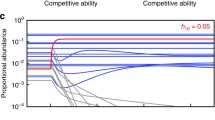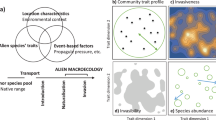Abstract
The 'invasiveness' of an alien species depends partly on its ability to become abundant and widespread in its new environment. While competitiveness may be an important component of this ability, so too is the abundance of resource or habitat. First, the local carrying capacity will depend on the local favourability of the habitat, hence the global density will depend on how widespread the habitat is. Second, and more subtly, the local density will also be affected by the global extent of favourable habitat, because of losses occasioned by dispersal when the population redistributes; these losses should be fewer the greater the contiguous area of favourable habitat or the more patches of such habitat across the landscape. Here we describe a model which demonstrates how habitat availability affects an invading speciesèquilibrium abundance, hence its invasiveness. The model shows that local density is likely to be an increasing function of global habitat abundance, and global density to be a non-linear, concave-up function of global habitat abundance. Examples are given to support the model's predictions, taken largely from alien species in New Zealand.
Similar content being viewed by others
References
Barlow ND, Moller H and Beggs JR (1996) A model for the effect of Sphecophaga vesparum vesparum as a biological control agent of the common wasp in New Zealand. Journal of Applied Ecology 33: 31–44
Barlow ND, Kean JM, Phillips CB and Goldson SL (1999) New perspectives in biological control modelling. Proceedings of the 7th Australasian Conference on Grassland Invertebrate Ecology, pp 99–105
Barratt BIP, Barker GM and Addison PJ (1996) Sitona lepidus Gyllenhal newly established in New Zealand: assessment of distribution in the North Island. Proceedings of the 49th New Zealand Plant Protection Conference, pp 266–269
Bascompte J, Possingham H and Roughgarden J (2002) Patchy populations in stochastic environments: critical number of patches for persistence. The American Naturalist 159: 128–137
Beggs JR (2000) The ecological consequences of social wasps (Vespula spp.) invading an ecosystem that has an abundant carbohydrate resource. Biological Conservation 99: 17–28
Dixon AFG and Kindlmann P (1990) Role of plant abundance in determining the abundance of herbivorous insects. Oecologia 83: 281–283
Flather CH and Bevers M (2002) Patchy reaction–diffusion and population abundance: the relative importance of habitat amount and arrangement. The American Naturalist 159: 40–56
Hengeveld R and van den Bosch F (1997) Invading into an ecologically non-uniform area. In: Huntley B, Cramer W, Morgan AV, Prentice HC and Allen JRM (eds) Past and Future Rapid Environmental Changes, pp 217–225. Springer, Berlin
Jonsen ID, Bourchier RS and Roland J (2001) The influence of matrix habitat on Aphthona flea beetle immigration to leafy spurge patches. Oecologia 127: 287–294
Kean JM and Barlow ND (2000) A spatial model for the successful biological control of Sitona discoideus by Microctonus aethiopoides. Journal of Applied Ecology 38: 162–169
Mack RN, Simberloff D, Lonsdale WM, Evans H, Clout M and Bazzaz FA (2000) Biotic invasions: causes, epidemiology, global consequences, and control. Ecological Applications 10: 689–710
McKelvey K, Noon BR and Lamberson RH (1993) Conservation planning for species occupying fragmented landscapes: the case of the northern spotted owl. In: Kareiva PM, Kingsolver JG and Huey RB (eds) Biotic Interactions and Global Change, pp 424–450. Sinauer Associates, Massachusetts
Murray PJ and Clements RO (1995) Distribution and abundance of three species of Sitona (Coleoptera: Curculionidae) in grassland in England. Annals of Applied Biology 127: 229–237
Murray PJ, Dawson LA and Grayston SJ (2002) Influence of root herbivory on growth response and carbon assimilation by white clover plants. Applied Soil Ecology 20: 97–105
Ricker WE (1954) Stock and recruitment. Journal of the Fisheries Research Board of Canada 11: 559–623
Rohitha BH (1979) Some aspects of the biology, damage, population dynamics and flight of A. kondoi Shinji (Homoptera: Aphididae) in Canterbury, New Zealand. PhD thesis. University of Canterbury, Lincoln College
Shigesada N and Kawasaki K (1997) Biological Invasions: Theory and Practice. Oxford University Press, New York
Vandermeer JH and Carvajal R (2001) Metapopulation dynamics and the quality of the matrix. American Naturalist 158: 211–220
Willoughby BE, Goldson SL, Addison PJ, Hardwick S, Gerard PJ and Eerens JPJ (1999) Clover root weevil (Sitona lepidus): the NewZealand response to a major biosecurity breach. Proceedings of the 7th Australasian Conference on Grassland Invertebrate Ecology, pp 35–42. CSIRO Entomology, Perth
Author information
Authors and Affiliations
Corresponding author
Rights and permissions
About this article
Cite this article
Barlow, N., Kean, J. Resource Abundance and Invasiveness: A Simple Model. Biological Invasions 6, 261–268 (2004). https://doi.org/10.1023/B:BINV.0000034590.77961.6e
Issue Date:
DOI: https://doi.org/10.1023/B:BINV.0000034590.77961.6e




